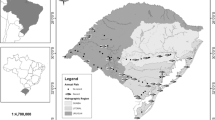Abstract
We present data on the habitat, density, and spatial distribution of Rivulus giarettai, and discuss some biotic and abiotic variables related to its abundance in Free Flowing Waters (FFW) and Dam Reservoirs (DR) in palm grove (Mauritia flexuosa) marshes (Veredas) in Uberlândia, Minas Gerais, southeastern Brazil. The mean density (individuals/plot) of R. giarettai was about 13 times higher in FFW than in DR. In FFW, the density of R. giarettai was highest at intermediate amounts of substrate (plant mass) and it was positively rank-correlated with the depth, and the number of arthropods. Individuals occurred in an aggregated distribution. The aggregated pattern could be related to a concentration of individuals in microhabitats neither too much exposed nor completely saturated by plants. R. giarettai was relatively abundant and tolerant to slight man-made habitat modifications. Damming appeared to be especially problematic by negatively affecting its density.




Similar content being viewed by others
References
Casatti L (2002) Alimentação dos peixes em um riacho do Parque Estadual Morro do Diabo, bacia do Alto Rio Paraná, Sudeste do Brasil. Biota Neotrop 2:1–14
Castro RMC, Casatti L (1997) The fish fauna from a small forest stream of the upper Paraná River basin, Southeasthern Brazil. Ichthyol Explor Freshwat 7:337–352
Costa WJEM (1995) Revision of Rivulus punctatus species complex (Cyprinodontiformes: Rivulidae). Ichthyol Explor Freshwat 3:207–226
Costa WJEM (2003) Family Rivulidae (South American Annual Fishes). In: Reis RE (ed) Checklist of the freshwater fishes of South and Central America. Edipucrs, Porto Alegre, pp 526–548
Costa WJEM (2006) Relationships and taxonomy of the killifish genus Rivulus (Cyprinodontiformes: Aplocheiloidei: Rivulidae) from the Brazilian Amazonas river basin, with notes on historical ecology. Aqua J Ichthyol Aquat Biol 11:133–155
Costa WJEM (2008) Rivulus giarettai, a new killifish from the Araguari River drainage, upper Paraná river basin, Brazil (Cyprinodontiformes: Rivulidae). Ichthyol Explor Freshwat 19:91–95
Giaretta AA, Kokubum MNC (2004) Reproductive ecology of Leptodactylus furnarius Sazima & Bokermann, 1978 a frog that lay eggs in underground chambers (Anura, Leptodactrylidae). Herpetoza 16:115–126
Gormam OT (1987) Habitat segregation in an assemblage of minnows in a Ozark stream. In: Mathews WJ, Heinz DC (eds) Community and evolutionary ecology of North American stream fishes. University of Oklahoma Press, Norman, pp 33–41
Gormam OT, Karr JR (1978) Habitat structure and stream fish communities. Ecology 59:507–515
Krebs CJ (1989) Ecological methodology. Harper Collins, New York
Matthews WJ (1998) Patterns in freshwater fish ecology. Chapman and Hall, New York
Melo CE, Machado FA, Pinto-Silva V (2004) Feedings habits of fish from a stream in the savanna of Central Brazil, Araguaia basin. Neotrop Ichthyol 2(1):37–44
Moyle PB, Senanayake FR (1984) Resourse partitioning among the fishes of rainforest streams in Sri Lanka. J Zool 202:195–223
Muniz KPR, Giaretta AA, Silva WR, Facure KG (2008) Auto-ecologia de Hypsiboas albopunctatus (Anura, Hylidae) em área de Cerrado no sudeste do Brasil. Iheringia, Série Zoologica 98:254–259
Novakowski GC, Hahn NS, Fugi R (2007) Alimentação de peixes piscívoros antes e após a formação do reservatório de Salto Caxias, Paraná, Brasil. Biota Neotrop 7:149–154
Oliveira PS, Marquis RJ (2002) The Cerrados of Brazil: ecology and natural history of a neotropical Savanna. Columbia University Press, New York
Partridge BL (1982) The structure and function of fishes schools. Sci Am 246:114–123
Persson L, Anderson J, Wahlstron E, Eklov P (1996) Size-specific interactions in lake ecosystems: predator gape-limitation and prey growth rate and mortality. Ecology 77:900–911
Popova OA (1978) The role of predacious fish in ecosystems. In: Gerking SD (ed) Ecology of firewater fish production. Blackwell Scientific, Oxford, pp 215–249
Sabino J, Castro RMC (1990) Alimentação, período de atividade e distribuição espacial dos peixes de um riacho da Floresta Atlântica (Sudeste do Brasil). Rev Bras Biol 50:23–36
Savino JF, Stein RA (1982) Predator-prey interaction between largemoth bass and bluegills as influenced by simulated, submersed vegetation. Trans Am Fish Soc 111:255–266
Savino JF, Stein RA (1989) Behavioral interactions between fish predators and their prey: effects of plant density. Anim Behav 37:311–321
Schaefer JF, Heullett ST, Farrell TM (1994) Interactions between two poeciliid fishes (Gambusia holbrooki and Heterandria formosa) and their prey in a Florida marsh. Copeia 2:516–520
Schindler I, Etzel V (2008) Re-description and distribution of Rivulus punctatus Boulenger, 1895 (Teleostei: Rivulidae) and its habits in Paraguay. Vertebr Zool 58:33–43
Scholosser IJ (1982) Fish community structure and function along two habitat gradients in a headwater stream. Ecol Monogr 52:395–414
Shaffer HB, Alford RA, Woodward BD et al (1994) Quantitative sampling of amphibian larvae. In: Heyer WR, Donnely MA, McDiarmid RW et al (eds) Measuring and monitoring biological diversity. Standard methods for amphibians. Smithsonian Institutions Press, Washington and London, pp 130–141
Shibatta OA, Bennemann ST (2003) Plasticidade alimentar em Rivulus pictus Costa (Osteichthyes, Cyprinodontiformes, Rivulidae) de uma pequena lagoa em Brasília, Distrito federal, Brasil. Rev Bras Zool 20:615–618
SPSS, Inc. (2000) Systat® version 10.0. SPSS, Inc., Chicago
Venupongal MM, Winfield IJ (1993) The distribution of juvenile fishes in a hyperreutrophic pond: can macrophytes potentially offer a refuge for zooplankton? J Freshw Ecol 8:389–396
Werner EE, Mittelbach GG, Hall DJ (1981) The role of foraging profitability and experience in habitat use by the bluegill sunfish. Ecology 62:116–125
Wooton JR (1998) Ecology of teleost fishes, 2nd edn. Kluwer Academic Press, New York
Zar JH (1999) Bioestatistical analysis, 4th edn. Prentice-Hall, New Jersey
Acknowledgements
Financial support by Conselho Nacional de Desenvolvimento Científico e Tecnológico and Fundação de Amparo à Pesquisa do Estado de Minas Gerais. A Grant by Conselho Nacional de Desenvolvimento Científico e Tecnológico to AAG. J. W. E. M. Costa and O. T. Oyakawa identified the teleosts. L. B. Martins, L. Magrini, T. R. de Carvalho, and W. R. Silva helped in field woks.
Author information
Authors and Affiliations
Corresponding author
Rights and permissions
About this article
Cite this article
Oliveira, L.E., Facure, K.G. & Giaretta, A.A. Habitat, density, and spatial distribution of Rivulus giarettai (Actinopterygii, Cyprinodontiformes) in southeastern Brazil. Environ Biol Fish 93, 89–94 (2012). https://doi.org/10.1007/s10641-011-9892-1
Received:
Accepted:
Published:
Issue Date:
DOI: https://doi.org/10.1007/s10641-011-9892-1




